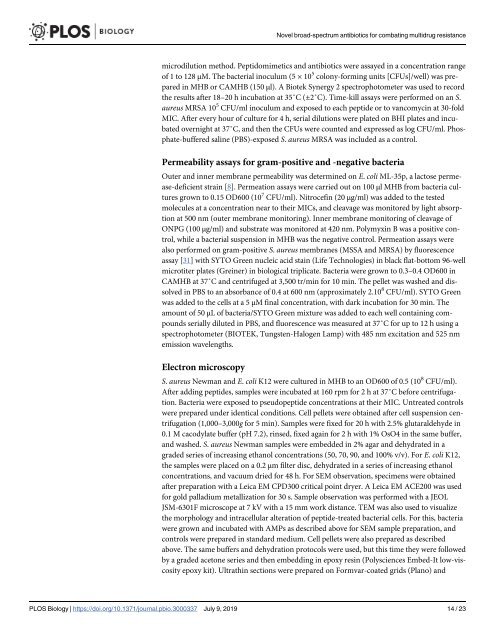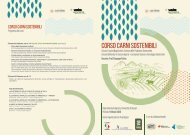Novel antibiotics effective against grampositive and -negative multi-resistant bacteria with limited resistance
Antibiotics are a medical wonder, but an increasing frequency of resistance among most human pathogens is rendering them ineffective. If this trend continues, the consequences for public health and for the general community could be catastrophic. The current clinical pipeline, however, is very limited and is dominated by derivatives of established classes, the “me too” compounds.
Antibiotics are a medical wonder, but an increasing frequency of resistance among most human pathogens is rendering them ineffective. If this trend continues, the consequences for public health and for the general community could be catastrophic. The current clinical pipeline, however, is very limited and is dominated by derivatives of established classes, the “me too” compounds.
You also want an ePaper? Increase the reach of your titles
YUMPU automatically turns print PDFs into web optimized ePapers that Google loves.
<strong>Novel</strong> broad-spectrum <strong>antibiotics</strong> for combating <strong>multi</strong>drug <strong>resistance</strong><br />
microdilution method. Peptidomimetics <strong>and</strong> <strong>antibiotics</strong> were assayed in a concentration range<br />
of 1 to 128μM. The <strong>bacteria</strong>l inoculum (5×10 5 colony-forming units [CFUs]/well) was prepared<br />
in MHB or CAMHB (150μl). A Biotek Synergy 2 spectrophotometer was used to record<br />
the results after 18–20 h incubation at 35˚C (±2˚C). Time-kill assays were performed on anS.<br />
aureus MRSA 10 5 CFU/ml inoculum <strong>and</strong> exposed to each peptide or to vancomycin at 30-fold<br />
MIC. After every hour of culture for 4 h, serial dilutions were plated on BHI plates <strong>and</strong> incubated<br />
overnight at 37˚C, <strong>and</strong> then the CFUs were counted <strong>and</strong> expressed as log CFU/ml. Phosphate-buffered<br />
saline (PBS)-exposedS.aureus MRSA was included as a control.<br />
Permeability assays for gram-positive <strong>and</strong> -<strong>negative</strong> <strong>bacteria</strong><br />
Outer <strong>and</strong> inner membrane permeability was determined onE.coli ML-35p, a lactose permease-deficient<br />
strain [8]. Permeation assays were carried out on 100μl MHB from <strong>bacteria</strong> cultures<br />
grown to 0.15 OD600 (10 7 CFU/ml). Nitrocefin (20μg/ml) was added to the tested<br />
molecules at a concentration near to their MICs, <strong>and</strong> cleavage was monitored by light absorption<br />
at 500 nm (outer membrane monitoring). Inner membrane monitoring of cleavage of<br />
ONPG (100μg/ml) <strong>and</strong> substrate was monitored at 420 nm. Polymyxin B was a positive control,<br />
while a <strong>bacteria</strong>l suspension in MHB was the <strong>negative</strong> control. Permeation assays were<br />
also performed on gram-positiveS.aureus membranes (MSSA <strong>and</strong> MRSA) by fluorescence<br />
assay [31] <strong>with</strong> SYTO Green nucleic acid stain (Life Technologies) in black flat-bottom 96-well<br />
microtiter plates (Greiner) in biological triplicate. Bacteria were grown to 0.3–0.4 OD600 in<br />
CAMHB at 37˚C <strong>and</strong> centrifuged at 3,500 tr/min for 10 min. The pellet was washed <strong>and</strong> dissolved<br />
in PBS to an absorbance of 0.4 at 600 nm (approximately 2.10 8 CFU/ml). SYTO Green<br />
was added to the cells at a 5μM final concentration, <strong>with</strong> dark incubation for 30 min. The<br />
amount of 50μL of <strong>bacteria</strong>/SYTO Green mixture was added to each well containing compounds<br />
serially diluted in PBS, <strong>and</strong> fluorescence was measured at 37˚C for up to 12 h using a<br />
spectrophotometer (BIOTEK, Tungsten-Halogen Lamp) <strong>with</strong> 485 nm excitation <strong>and</strong> 525 nm<br />
emission wavelengths.<br />
Electron microscopy<br />
S.aureus Newman <strong>and</strong>E.coli K12 were cultured in MHB to an OD600 of 0.5 (10 8 CFU/ml).<br />
After adding peptides, samples were incubated at 160 rpm for 2 h at 37˚C before centrifugation.<br />
Bacteria were exposed to pseudopeptide concentrations at their MIC. Untreated controls<br />
were prepared under identical conditions. Cell pellets were obtained after cell suspension centrifugation<br />
(1,000–3,000g for 5 min). Samples were fixed for 20 h <strong>with</strong> 2.5% glutaraldehyde in<br />
0.1 M cacodylate buffer (pH 7.2), rinsed, fixed again for 2 h <strong>with</strong> 1% OsO4 in the same buffer,<br />
<strong>and</strong> washed.S.aureus Newman samples were embedded in 2% agar <strong>and</strong> dehydrated in a<br />
graded series of increasing ethanol concentrations (50, 70, 90, <strong>and</strong> 100% v/v). ForE.coli K12,<br />
the samples were placed on a 0.2μm filter disc, dehydrated in a series of increasing ethanol<br />
concentrations, <strong>and</strong> vacuum dried for 48 h. For SEM observation, specimens were obtained<br />
after preparation <strong>with</strong> a Leica EM CPD300 critical point dryer. A Leica EM ACE200 was used<br />
for gold palladium metallization for 30 s. Sample observation was performed <strong>with</strong> a JEOL<br />
JSM-6301F microscope at 7 kV <strong>with</strong> a 15 mm work distance. TEM was also used to visualize<br />
the morphology <strong>and</strong> intracellular alteration of peptide-treated <strong>bacteria</strong>l cells. For this, <strong>bacteria</strong><br />
were grown <strong>and</strong> incubated <strong>with</strong> AMPs as described above for SEM sample preparation, <strong>and</strong><br />
controls were prepared in st<strong>and</strong>ard medium. Cell pellets were also prepared as described<br />
above. The same buffers <strong>and</strong> dehydration protocols were used, but this time they were followed<br />
by a graded acetone series <strong>and</strong> then embedding in epoxy resin (Polysciences Embed-It low-viscosity<br />
epoxy kit). Ultrathin sections were prepared on Formvar-coated grids (Plano) <strong>and</strong><br />
PLOS Biology | https://doi.org/10.1371/journal.pbio.3000337 July 9, 2019 14 / 23


















